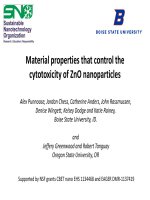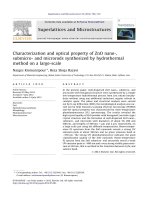Cytotoxicity of zno nanoparticles
Bạn đang xem bản rút gọn của tài liệu. Xem và tải ngay bản đầy đủ của tài liệu tại đây (958.07 KB, 23 trang )
Material properties that control the
cytotoxicity of ZnO nanoparticles
Supported by NSF grants CBET nano EHS 1134468 and EAGER DMR-1137419
Alex Punnoose, Jordan Chess, Catherine Anders, John Rassmussen,
Denise Wingett, Kelsey Dodge and Katie Rainey,
Boise State University, ID.
and
Jeffery Greenwood and Robert Tanguay
Oregon State University, OR
Preferential cytotoxicity of ZnO NP to cancer cells
Reported preferential killing of Jurkat and Hut-78 cancer cells by 8nm ZnO NP without
any measurable effect on normal T and B cells:
1. A. Punnoose, K. M. Reddy and D. Wingett, US Patent No: 8,187,638, Preferential killing of cancer
cells and activated human T cells using ZnO nanoparticles.
2. Reddy, et al., Selective toxicity of zinc oxide nanoparticles to prokaryotic and eukaryotic systems.
Applied Physics Letters, 2007, 90, p. 213902.
3. Hanley, et al, Preferential killing of cancer cells and activated human T cells using zinc oxide
nanoparticles. Nanotechnology, 2008. 19: p. 295103.
4. Hanley, C., et al., Nanoscale Research Letters, 2009, 4: p. 1409.
5. Thurber, et al, Nanotoxicology 2012, 6: p. 440-452.
NP toxicity to cancer cells
0%
20%
40%
60%
80%
100%
0 0.1 0.2 0.3 0.4 0.5
[NP] in mM
% viable cells
Jurkat
Hut-78
normal T cells
ZnO NP toxicity: Conflicting reports
Preferential cytotoxicity of ZnO NP to cancer cells was observed by other groups:
1. Ostrovsky, S., et al., Selective cytotoxic effect of ZnO nanoparticles on glioma cells. Nano
Research, 2009. 2: p. 882.
2. Sasidharan, A., et al., Rapid dissolution of ZnO nanocrystals in acidic cancer microenvironment
leading to preferential apoptosis. Nanoscale, 2011. 3: p. 3657.
3. M. Premanathan, et al., Selective toxicity of ZnO nanoparticles toward Gram-positive bacteria
and cancer cells by apoptosis through lipid peroxidation. Nanomedicine: NBM, 2011. 7: p. 184.
4. L. Taccola, et al, Zinc oxide nanoparticles as selective killers of proliferating cells. International
Journal of Nanomedicine, 2011. 6: p. 1129.
Strong toxic response of ZnO NP to normal healthy cells, snails and embryonic zebrafish:
1. George, S., et al., Use of a Rapid Cytotoxicity Screening Approach To Engineer a Safer Zinc Oxide
Nanoparticle through Iron Doping. ACS Nano, 2010. 4: p. 15-29.
2. Brunner, T.J., et al., In vitro cytotoxicity of oxide nanoparticles: comparison to asbestos, silica, and
the effect of particle solubility. Environmental science technology, 2006. 40: p. 4374.
3. Croteau, M.N., et al., A novel approach reveals that zinc oxide nanoparticles are bioavailable and
toxic after dietary exposures. Nanotoxicology, 2010. 5: p. 79.
4. Bai, W., et al., Toxicity of zinc oxide nanoparticles to zebrafish embryo: a physicochemical study of
toxicity mechanism Journal of Nanoparticle Research, 2010. 12: p. 1645.
5. Sun, J., et al., Cytotoxicity, permeability, and inflammation of metal oxide nanoparticles in human
cardiac microvascular endothelial cells, Cell Biol Toxicol., 2011. 27: p. 333.
What makes identical NP?
ZnO-I: Forced hydrolysis of Zn
acetate dehydrate using diethylene
glycol (DEG) as the solvent.
ZnO-II: Forced hydrolysis of Zn
acetate dehydrate using denatured
ethanol, using LiOH to maintain
correct pH; aged in n-Heptane.
X-ray diffraction shows single phase wurtzite
ZnO with average crystallite size of 8 ± 2 nm for
both ZnO-I and ZnO-II. Lattice parameters
were around a=3.25± 0.0003 Å and c=5.21±
0.003 Å.
Journal of Applied Physics 113, 17C302 (2013).
Physical Review B 82, 054419 (2010).
Morphology - ZP
TEM confirmed crystallite
size ~8nm.
Energy Dispersive
Spectroscopy and X-ray
Photoelectron
Spectroscopy confirmed
elemental composition.
Zeta potential:
ZnO-I: 40mV
ZnO-II: 12mV
Zeta Potential
5 6 7 8 9 10 11 12
-60
-50
-40
-30
-20
-10
0
10
20
30
40
50
Zeta Potential (mV)
pH
ZnO 1 4 nm
ZnO 1 8 nm
ZnO 2 5 nm
ZnO 2 7 nm
ZnO – I show
larger ZP in
the +30 to
50m V
ZnO – II NP
show much
lower ZP <
+20 mV
FTIR Spectroscopy: Surface structure
ZnO-I has
surface
adsorbed DEG
layer
Both show
surface adsorbed
groups related to
acetate and
significant
hydroxyl bands.
Optical/PL properties of ZnO NP
350 400 450 500 550
Normalized PL Intensity (a.u.)
Wavelength (nm)
As-prepared
ZnO-II
3.50282 2.51012
ZnO-I
Normalized PL Intensity (a.u.)
As-prepared
The PL spectra recorded at 10K
using a 325 nm He:Cd laser.
Both samples show the UV emission
band at ~3.37 eV due to near band-
edge transition of wide band gap ZnO
NPs (free exciton recombination).
ZnO-II NP show large green
emission near 500nm. Large
number of defects (oxygen
vacancies/ interstitials)?
ZnO NP
size
(nm)
a (Å)
c (Å)
vol
(ų)
NC021
12.892
3.2547
5.2169
47.859
NC040
6.7066
3.2602
5.2231
48.077
NC042
9.9511
3.2595
5.2222
48.051
NC043
9.3459
3.2606
5.2265
48.121
NC044
8.2834
3.2606
5.2262
48.119
NC045
9.9555
3.2602
5.2236
48.083
NT010
10.916
3.2586
5.2185
47.989
NT114
9.3787
3.2582
5.2208
47.999
QC016
9.1523
3.2586
5.2202
48.006
QC017
10.463
3.2549
5.2153
47.849
QC019
8.4146
3.2576
5.225
48.019
Modified physico-chemical properties by varying hydrolysis ratio, reaction
temperature, centrifuge speed, number of washing cycles, etc
Toxicity of modified
ZnO NP to CD4 T
cells and Hut 78
cancer cells
Trend lines depicting
toxicity levels of
nanoparticles. Blue=Hut
78 and Red=CD4 T cells. Y-
axis is viability detected by
PI via FACS and x-axis is
mM concentration of
nanoparticle.
Role of surface charge/ZP of ZnO NP
Role of hydrodynamic size of ZnO NP
Role of catalytic activity of ZnO NP
• Rhodamine B as a model dye to evaluate the catalytic activity
using absorbance peak at 553nm.
• The photocatalytic rate constant k,
kt = ln(C
0
/C)
(where t = time, C
0
= initial concentration of RhB molecules,
and C = concentration after UV irradiation).
• UV reactor with 2537 Å UV lamps delivering 3.2mW/cm
2
• No UV lamp for Dark experiments
Journal of Applied Physics 113, 17B504 (2013).
Catalytic activity of ZnO NP: UV vs Dark
NC021
NC040
NC042
NC043
NC044
NC045
NT114
QC019
QC016
QC017
0.00026
0.00028
0.00030
0.00032
0.00034
0.00036
0.00038
0.00040
0.00042
0.00044
0.00046
k in dark
k in light
Samples
Rate constant in dark
0.04
0.06
0.08
0.10
0.12
0.14
0.16
0.18
0.20
0.22
0.24
Rate constant in light/UV
Catalytic activity of ZnO NP in Dark (no UV)
450 500 550 600
0.00
0.05
0.10
0.15
0.20
0.25
Arb. units
Wavelength (nm)
RhB
Bulk ZnO
NC021
QC016
NC044
NC045
ZnO NP in Dark, no UV
Catalytic activity of ZnO NP in dark
0.00030 0.00035 0.00040 0.00045
0.25
0.30
0.35
0.40
0.45
0.50
0.55
0.60
IC
50
Catalytic rate constant k (in dark)
Using PI and FACS
Using Alamar Blue
Role of catalytic activity of
ZnO NP on Hut-78 Cancer cells
Conclusions
• ZnO NP display selective toxicity to cancer cells.
• Toxicity depends on the physico-chemical properties such
as surface charge, hydrodynamic size and catalytic activity.
• Synthesis methods, precursors and media, and reaction
conditions and parameters significantly influence the
physicochemical properties and cytotoxicity.
• Surface structure and defects plays the most important
role in cytotoxicity – FTIR, ZP, PL are important to compare
samples.
• Ability to tailor the critical materials/surface properties will
allow the development of design rules for eliminating
unwanted toxicity as well as to tailor cell specific toxicity for
nanomedicinal applications.
Size
k
-dark
k
-UV
selectivity
%
CD4
IC50
FITC
Hut
-
78
ic50
facs
Hut
-
78
IC50 AB
ZP
(mV)
Hydrodynamic
size (nm)
NC021
13
3.67E-
04
0.0825
19.5
7.8
0.4
0.32
32
268.4
NC040
6.7
4.38E-
04
0.0396
18.9
7
0.37
0.27
45.6
239.9
NC042
10
4.32E-
04
0.0773
39.2
14.7
0.38
0.28
50.3
379.3
NC043
9.3
4.27E-
04
0.0891
31
11.8
0.38
0.3
47.8
453.7
NC044
8.3
4.33E-
04
0.0671
28.9
10.4
0.36
0.29
48.4
435.5
NC045
10
4.13E-
04
0.0848
19.4
6.8
0.35
0.37
44.6
367.2
NT114
9.4
4.31E-
04
0.128
40.5
15
0.37
0.31
42.6
623.7
QC019
8.4
2.91E-
04
0.0758
21.1
9.3
0.44
0.48
12.3
1860
QC016
9.2
2.80E-
04
0.0525
20.2
11.3
0.56
0.45
12.5
2386
QC017
10.5
3.23E-
04
0.0711
22.7
10.2
0.45
0.38
23.3
1395
Catalytic activity of ZnO NP in dark
0 100 200 300 400 500
-0.05
-0.04
-0.03
-0.02
-0.01
0.00
0.01
0.02
0.03
0.04
0.05
lnC/C0
Time (min)
RhB
NT010
QC017
NT114
NC042
Bulk
NT034
NC021
NC045
NC044
QC019
QC016
Water
Zeta Potential
5 6 7 8 9 10 11 12
-60
-50
-40
-30
-20
-10
0
10
20
30
40
50
Zeta Potential (mV)
pH
ZnO 1 4 nm
ZnO 1 8 nm
ZnO 2 5 nm
ZnO 2 7 nm
ZnO – I show
larger ZP in
the +30 to
50m V
ZnO – II NP
show much
lower ZP <
+20 mV
0.02 0.04 0.06 0.08 0.10 0.12 0.14
0.20
0.25
0.30
0.35
0.40
0.45
0.50
0.55
0.60
Hut 78 cancer cells
and ZnO NP
Using PI and FACS
Using Alamar Blue
IC
50
(mM of ZnO NP)
Rate constant k (using RhB)









